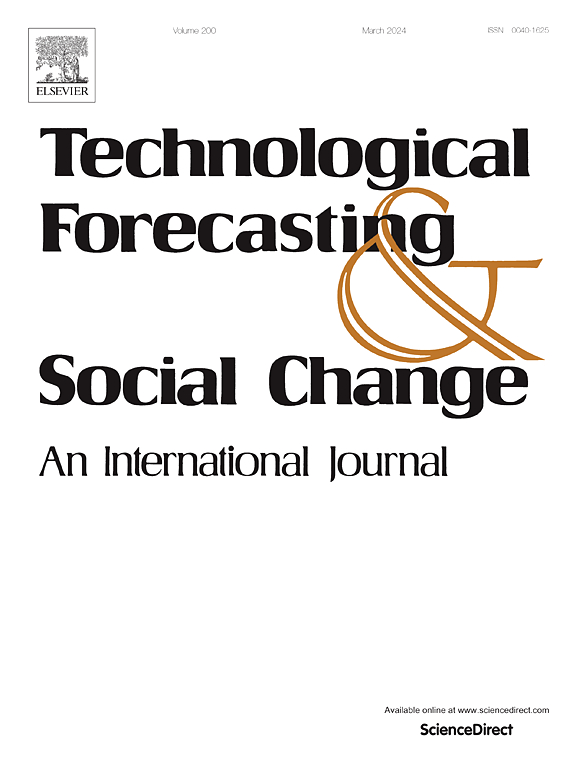“Assessment of circular economy strategies for climate change mitigation”: A forecast on India's path to a net zero future
IF 13.3
1区 管理学
Q1 BUSINESS
Technological Forecasting and Social Change
Pub Date : 2025-07-29
DOI:10.1016/j.techfore.2025.124294
引用次数: 0
Abstract
The escalating global challenge of climate change necessitates the adoption of sustainable strategies, particularly those aligned with circular economy (CE) principles. This study examines the role of CE strategies in mitigating climate change, with a specific focus on India—a major contributor to greenhouse gas emissions. Grounded in the principles of sustainable development and the carbon reduction targets outlined in the Paris Agreement, this research investigates how CE strategies can support India's climate change mitigation efforts. Additionally, it explores the influence of global corporate strategies in shaping India's approach to sustainability. A comprehensive literature review and expert consultations were conducted to identify and prioritize relevant CE strategies using the Best Worst Method (BWM). The Interpretive Structural Modeling (ISM) technique was then applied to analyze the interdependencies among these strategies. The findings of this study inform that a shift away from technical outputs toward biological ones through the use of biologically-based materials and processes (SOC3), altering production methods to produce less trash (SOC2), conserving resources (RIR4), and changes made to replace non-renewable resources with renewable ones (RIR3) have stood out as important ways to deal with climate challenges and help get to net-zero emissions. The study offers significant managerial, practical, and social implications, particularly for policymakers, industry leaders, and stakeholders seeking to integrate CE strategies into organizational and governmental frameworks. Given India's ambitious net-zero target by 2070, the prioritization and systematic implementation of CE strategies are imperative for fostering long-term sustainability and economic resilience.
“对减缓气候变化的循环经济战略的评估”:对印度走向零净未来道路的预测
气候变化的全球挑战不断升级,需要采用可持续战略,特别是与循环经济原则相一致的战略。本研究考察了环保战略在减缓气候变化方面的作用,并特别关注印度——温室气体排放的主要贡献者。本研究以《巴黎协定》中概述的可持续发展原则和碳减排目标为基础,调查了环保战略如何支持印度的气候变化减缓努力。此外,它还探讨了全球企业战略在塑造印度可持续发展方法方面的影响。采用最佳最差法(Best - Worst Method, BWM)对相关CE策略进行了全面的文献回顾和专家咨询,以确定其优先级。然后应用解释结构建模(ISM)技术分析这些策略之间的相互依赖关系。这项研究的结果表明,通过使用基于生物的材料和工艺(SOC3)、改变生产方法以产生更少的垃圾(SOC2)、节约资源(RIR4)以及用可再生资源(RIR3)取代不可再生资源,从技术产出转向生物产出,这些都是应对气候挑战和帮助实现净零排放的重要途径。该研究提供了重要的管理、实践和社会意义,特别是对政策制定者、行业领导者和利益相关者寻求将CE战略整合到组织和政府框架中。鉴于印度到2070年雄心勃勃的净零目标,优先考虑和系统实施节能减排战略对于促进长期可持续性和经济弹性至关重要。
本文章由计算机程序翻译,如有差异,请以英文原文为准。
求助全文
约1分钟内获得全文
求助全文
来源期刊
CiteScore
21.30
自引率
10.80%
发文量
813
期刊介绍:
Technological Forecasting and Social Change is a prominent platform for individuals engaged in the methodology and application of technological forecasting and future studies as planning tools, exploring the interconnectedness of social, environmental, and technological factors.
In addition to serving as a key forum for these discussions, we offer numerous benefits for authors, including complimentary PDFs, a generous copyright policy, exclusive discounts on Elsevier publications, and more.

 求助内容:
求助内容: 应助结果提醒方式:
应助结果提醒方式:


